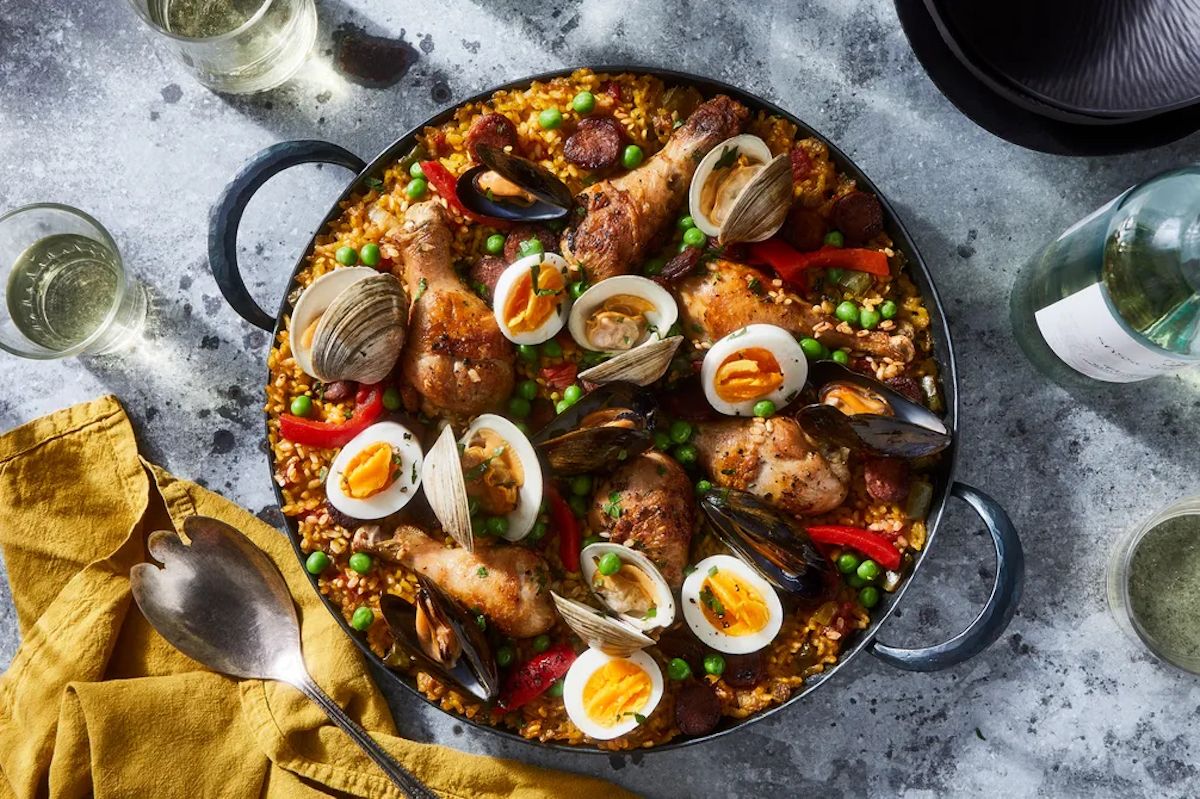In Mallorca, 83-year-old Maria Gibert is a local celebrity. Her YouTube channel, Recetas Mallorquinas, a lo-fi cooking show where Gibert shares traditional Mallorcan recipes from her sunny kitchen in Palma, has nearly 40,000 subscribers. She's appeared on Spanish national television, and regularly graces the pages of the local daily, "Diario de Mallorca," both as a recipe contributor and the focus of feature articles. Though Gibert's grandchildren manage her social media, she's aware of her influencer status. "People stop me in the streets and ask to take a photo with me," says Gibert. The self-proclaimed #AbuelaYouTuber is the island's home-cooking grandma — and the unofficial guardian of its cuisine, which is arguably underrated.
Spain is known for its regional gems, but the Balearic Islands have yet to fully claim a place on the culinary map. As my Mallorcan mother-in-law, Teresa, tells me, "People who travel to Mallorca think we eat dishes from other Spanish provinces — like Valencian paella or Asturian fabada. Even Spanish people think we eat just tree fruits and tomatoes," she says with a laugh. "They have no idea that we have our own gastronomy."
As a tourist destination, however, Mallorca is well established: its narrow roads lined with apricot-colored stone walls and blue-green coves are prime Instagram fodder.
Palma, Mallorca's capital, where Gibert was born and raised, is a modern city — local friends have described it as a miniature Barcelona. It's a far cry from the city of Gibert's youth. She recalls when Palma was small, provincial even, with low-rise buildings, palatial fincas, and enough space that most families had their own gardens. "People would grow their vegetables — Swiss chard, spinach, and cauliflower — and eat whatever they grew," says Gibert. "The vegetables tasted better."
On a Friday morning in April, I'm seated across from Gibert in her pin-neat living room in Palma. We're both wearing masks, and her hair is styled in a perfect ginger coif, just as it appears in her nearly 150 YouTube videos, some of which, like her coca de trampó recipe, have more than 300,000 views. Her pressed slacks are paired with a bedazzled sweater that reads "Paris." We're joined by her daughter, María Ángeles, who occasionally repeats my questions in the local tongue, Mallorquí, and has taken to preparing recipes for the Recetas Mallorquinas Instagram account as her mom recovers from a back injury. She may have physical setbacks, but Gibert's mind is knife-sharp — she regularly finishes answers with an interrogative "eh?" as if checking to make sure I got everything.
In true grandma form, the living room shelves are filled with framed pictures of Gibert's family, including 10 grandchildren and four, soon to be five, great-grandchildren. Just outside, there's a covered terrace overlooking the port filled with yachts, fishing boats, and a huge ferry that arrives every morning from Barcelona. In pre-COVID times, the family would regularly gather here for lunch, and their matriarch would prepare one of her classic, multicourse meals.
* * *
Growing up, Gibert's mother presided over the kitchen, cooking for Gibert, her six brothers and sisters, her father, and an aunt. A daily table of 10 required planning and economy. Eating seasonally was a matter of course and practicality. An average lunch would entail a dish like bullit: similar to a Madrileño cocido, it's made by stewing meat, potatoes, and beans with various bones and fatty animal parts that are often discarded — the ingredients that butchers set aside for people in-the-know. For the first course, they'd serve the broth, enriched and deceivingly heavy. Then, for the second course, they'd eat the tender meat and vegetables. Nothing went to waste.
In the summertime, the seven siblings would each pack a few belongings into a tied handkerchief and travel to their grandparents' home in the rural town of Felanitx. By car, it's less than an hour's drive, but back then, the roads were yet to be built. Gibert recalls, "We went by train, which in those days was fueled by charcoal, and when we arrived, our noses were completely black. Then one of my aunts would come to pick us up in a cart pulled by a donkey." There, she remembers the women of the family preparing meals over the chimney with fire — a superior cooking method, according to Gibert. "If you make arroz brut or paella with the flavor from the smoke and the fire, they taste even better," she says.
By the time she was 20 years old, both of Gibert's parents had passed away. Gibert, who had always gravitated toward the kitchen, assumed the role of household cook. When I ask what kind of things she cooked for her siblings, she replies, "They ate what I made, eh," without missing a beat. But, she says in all seriousness, la bolsa, or the family budget, came first.
* * *
I ask to see Gibert's kitchen, where the filming magic happens, and she's happy to show me around. It's a compact space, with lacquered red cabinets and sun pouring in through a window overlooking the port. Hanging on the wall, there's a photo collage of Gibert with television crews and during public appearances. There's also a framed caricature-ish portrait of her, which has been reprinted on an apron that Gibert dons in most of her videos. Not a knife is out of place; even the sink is immaculate.
"I've had 10 people in here," says Gibert, referring to the cooking classes she taught at home before she was encumbered by a back injury. It's hard to imagine, because of the size of the space, but also easy to understand given the popularity of her recipes among locals.
As for her own culinary education, Gibert was mostly an autodidact, though she did learn a few techniques from her second husband, a professional cook. But there was a limit to how much he could teach her. "We fought a lot in the kitchen," says Gibert. "Two roosters in a henhouse doesn't go well."
It wasn't until age 54, at the encouragement of a friend, that Gibert channeled her love of cooking into teaching. She began with a small class of a few friends and family members, and by word of mouth, the demand for her courses grew. Gibert took naturally to the role of instructor. "I started late, but I worked hard," says Gibert. "The more I was in charge of, the more I enjoyed it."
When in 2012, one of Gibert's grandsons proposed launching a YouTube channel, it made sense to translate her encyclopedic knowledge of Mallorcan cuisine into a modern, readily consumable format that could reach beyond the island. Unsurprisingly, Gibert was a natural in front of the camera, with a lack of self-consciousness that only decades of life can endow. In each video, what comes through is her passion for the kitchen and a deep understanding of her recipes, earned by preparing them hundreds of times.
She tells you not just which ingredients to add, but also what to feel and look for. When preparing the dough for empanadillas, "the dough has to be soft," says Gibert, kneading and rolling a piece for the camera. The dough for her famous coca de cebolla y sobrasada — a flatbread layered with caramelized onions and a spiced, local sausage — is ready when it pulls away from the bowl. Certain twists are surprising, like the generous pour of vinegar she adds to aioli, but once you try her time-tested version, you'll never do it the old way — and your family will thank you.
I own one Mallorcan cookbook — a tome published in 1974 that I found at a local flea market — but as far as cookbooks that have found an audience beyond the Balearics, no titles come to mind. Joan Sastre, a photographer and excellent home cook (who, as it happens, prepared the insanely delicious aguiat de pilotes — meatball stew — served at my Mallorca wedding reception), assures me that any local bookstore will have a number of Balearic cookbooks, at least in Spanish and Mallorquí. But I wonder if maybe the time is ripe for a comprehensive modern guide.
"When I leave, I'd love to leave behind a cookbook," Gibert tells me, when I ask if one is in the cards for her. That said, if preserving her island's culinary patrimony is the goal, by many accounts, she's already succeeded.
I ask her to describe Mallorcan cuisine, and she says it's delicious and that there are so many dishes to try. Her favorite is the sopa mallorquina in all of the soup's seasonal varieties: with artichokes and spinach in the spring; fish and grated tomatoes in the summer; mushrooms and game in the fall. Then she nods, thinking about it for a moment, "Mallorcan cuisine is making a comeback."




Shares